The Val News Observer One!Take
Wilson Picks Up Baton to Remove Slavery Language From California’s Constitution
Media
California Black
Samual Nathaniel Brown said he is not surprised that
Assemblymember Lori Wilson (D-Suisun City) picked up the baton to carry on the fight to eradicate the phrase “involuntary servitude except as a punishment to crime” from California’s Constitution.
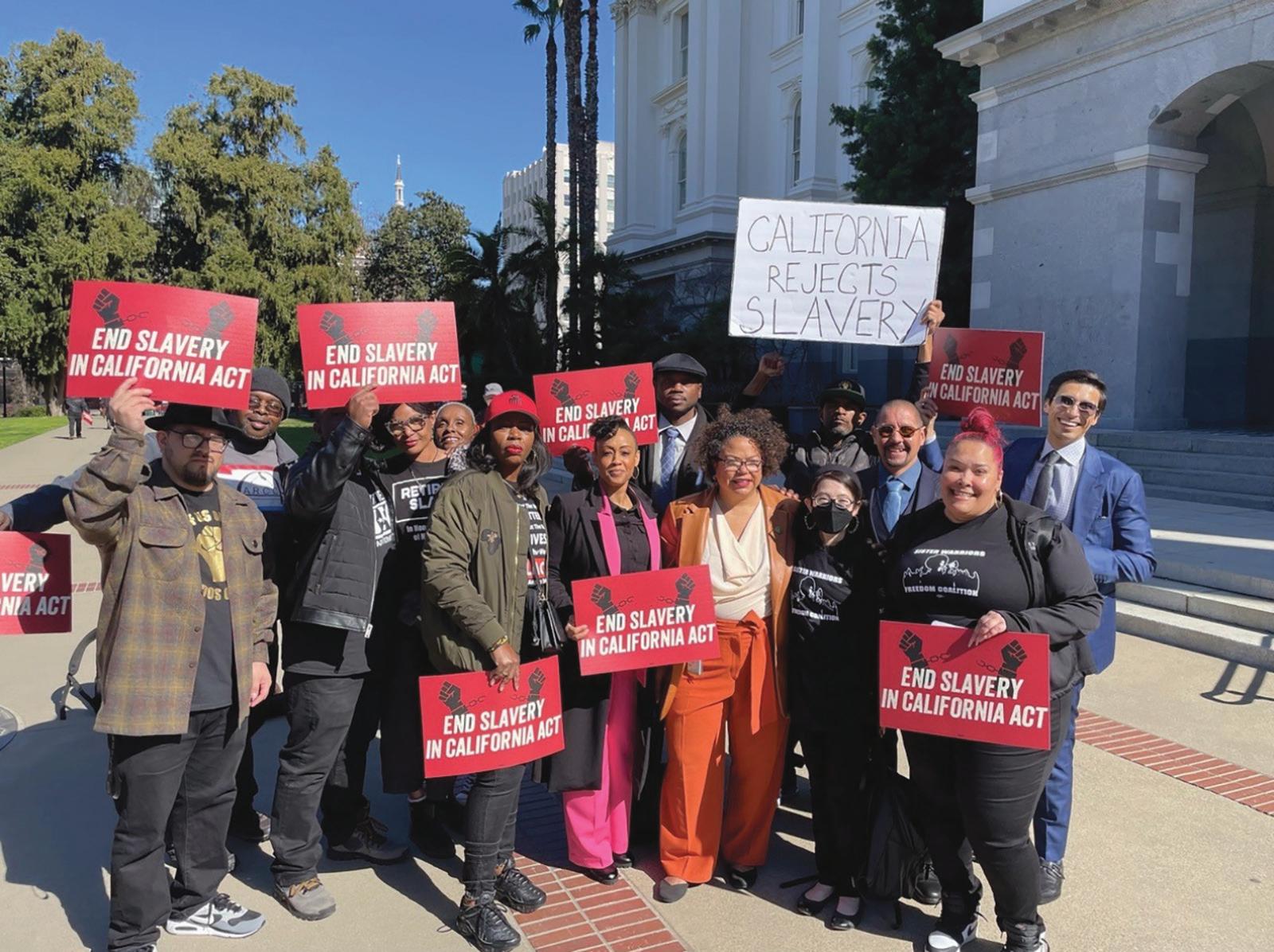
Brown, who contributed to writing Assembly
Constitutional Amendment (ACA) 3, the California Abolition Act, while he was incarcerated in prison, stood on the west steps of the state Capitol in Sacramento with Wilson when she reintroduced a new iteration of the legislation that failed to pass in the State Senate last year.
This time around, Brown, Wilson and other supporters of the End Slavery in California Act say they are determined to retire the constitutional clause that allows labor imposed on felons as criminal punishment in California prisons.
“To be honest, we didn’t have to lure her in at all. She was a more-than-willing participant to pick up the baton,” Brown said on the Feb.19 edition of Abolition Today. “Championing the causes of Black people is something she has been doing for a long time and has done in almost every position she has held. It’s a no-brainer for her to continue this fight.”
Abolition Today is a weekly online radio program with specific focus on “modern-day slavery” as it is practiced through the 13th Amendment of the US constitution. It is hosted by Max Parthas and Yusuf Hassan.
California is among 16 states with an “exception clause” for involuntary servitude in its state constitution, Wilson said. Should the state legislature pass the End Slavery in California Act, voters will decide during the 2024 General Elections if it will become state law.
Three states — Colorado, Utah, and Nebraska –have voted to abolish slavery and involuntary servitude. Alabama, Oregon, Tennessee and Vermont have approved similar ballot measures.
Continued on page A2
California Black Caucus Black History Month Event Celebrates Business Owners
Antonio Ray Harvey California Black Media
The California Black Chamber of Commerce (CBCC) and the California Legislative Black Caucus (CLBC) recognized the success of 16 thriving Black-owned businesses at its annual Legislative Business Brunch at the Citizen Hotel in Sacramento.
The brunch, organized to celebrate Black History Month, honored the achievements of the businesses, and celebrated their commitment to professional service and making an impact on the economy of communities around California.
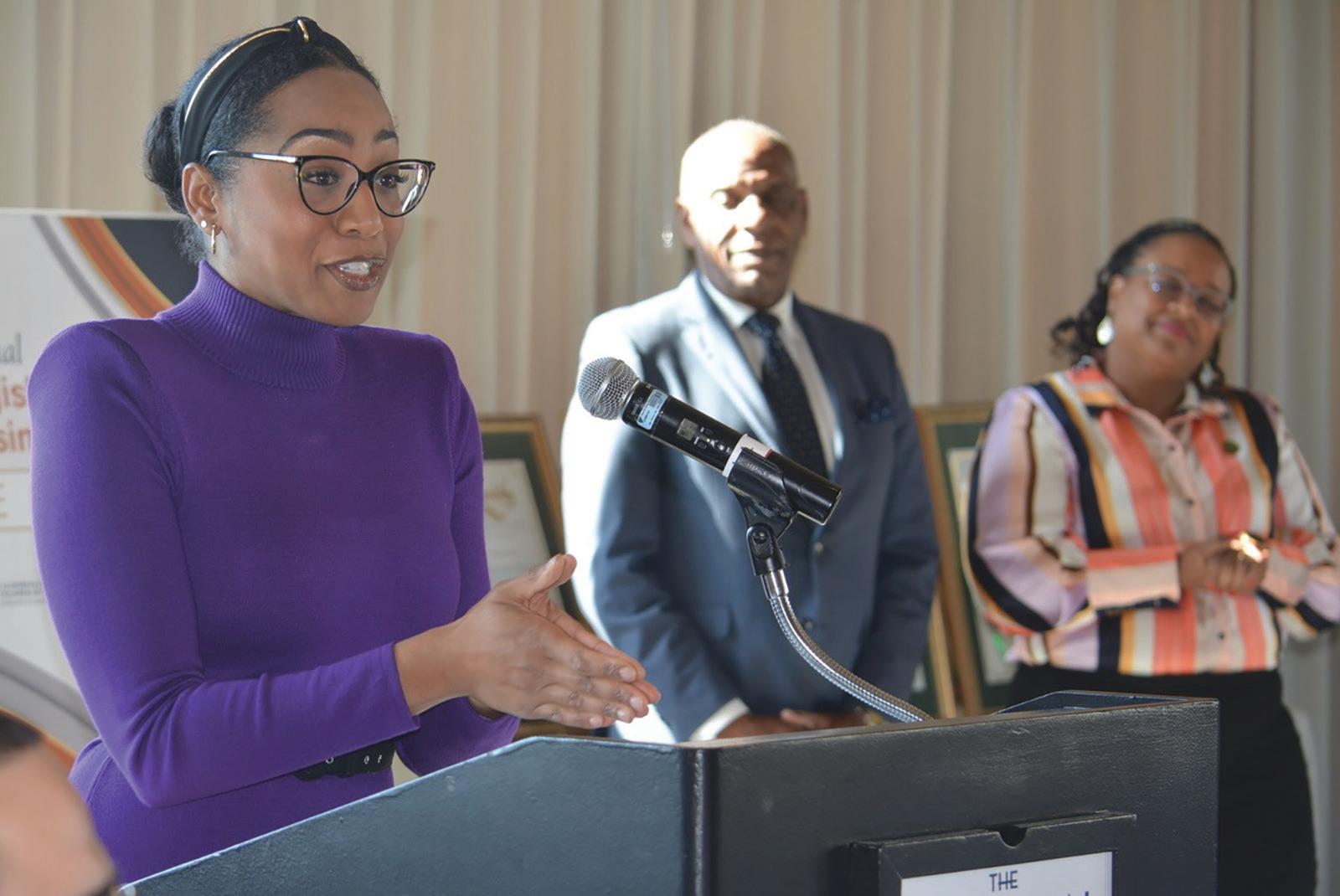
“I am thankful that today, as it being the month of

City), chair of the CLBC. “You are making an economic impact, not only for your families but for those that you employ and those that you provide good service to.”
Sponsored by Amazon and Instacart, the business program attracted Black business leaders, non-profit operators, and all 12 members of the CLBC. Three Black constitutional officers – Secretary of State Dr. Shirley Weber, State Controller Malia Cohen and Superintendent of Public Instruction Tony Thurmond -- were recognized at the event held at Citizen Hotel.
Tempe AZ Considers Replacing Street Names Tied to KKK
TEMPE, Ariz. (AP) – An Arizona city council scheduled a vote next month on replacing park and road names that have century-old ties to the Ku Klux Klan.
Tempe councilmembers will consider replacement names during a March 2 meeting. The new names were proposed by community members and vetted by councilappointed volunteers who met several times.
The renaming effort began in 2021 after historical research determined that several parks and streets were named after former community leaders who were members of an area Klan chapter in the 1920s. Resident Drew Sullivan helped start the initiative and staffers at the Arizona Historical Society and Tempe History Museum had a hand in the research, which also used records from the Phoenix Public Library.
A Klan chapter called Butte Klan No. 3 included many prominent Tempe residents, including mayors, council members, bankers and other power brokers, according to documents released by the city. At the time, the city’s elementary schools were segregated, as was a swimming pool at Tempe Beach Park.
The Tempe Elementary School District already has renamed three schools bearing some of the associated names.
Tempe city officials in February settled on the list of proposed replacement names, which includes civil rights activists, the first African American landowners in what is now Tempe, and married pioneers Adolfo Romo and Joaquina Jones, who fought and won in court for their children to be able to attend school with white children. Their 1925 case helped pave the way for desegregation in the United States.
“This is really touching to me because I’ve had people (in my family) who have died by hanging by the Ku Klux Klan, so I understand what this means emotionally,’’ Berdetta Hodge, the first Black woman to sit on the city council, told the Arizona Republic.
Pending action by the City Council, it could be the summer for the actual name changes are made.
The city is still organizing how it will reimburse residents who have to update their addresses. Residents will have one year to file claims after the properties are officially renamed.
Naval Academy Renames Building after Jimmy Carter
ANNAPOLIS, Md. (AP) – A building at the U.S. Naval Academy that had been named after a leader in the Confederate Navy was renamed Friday in honor of former President Jimmy Carter, who graduated from the academy in 1946.
The decision to rename the engineering building in Annapolis was made after a commission mandated by Congress determined several military assets across all branches of the service had to be renamed because of Confederate ties.
The building that had been called Maury Hall was built and named in the early 1900s after Matthew Fontaine Maury, a naval officer and scientist who joined the Confederates.
The event’s program was presented by Wilson, CBCC’s President and CEO Jay King, and CLBC vice chair Sen. Steven Bradford (D-Inglewood). Anthony Williams, the California Public Policy Director for Amazon, was the guest speaker.
King reminded the attendees that the event was made possible by Aubry Stone, who started the advocacy for Black businesses in the state in 1995 until his passing in November 2018.
The Naval Academy superintendent’s house and a nearby road are named after Franklin Buchanan, the academy’s first superintendent who left to join the Confederate Navy at the start of the Civil War. The academy also is renaming the house and road, but has yet to announce those changes.
Carter, who is 98, was president from 1977 to 1981. He did not attend the ceremony, though some of his relatives did.
¡It would be impossible to overstate what this Academy and the Navy has meant to my grandfather, and by extension to my family,’’ said Josh Carter, Jimmy Carter’s grandson, in a news release from the Navy.
Cohen and Thurmond were present to accept their awards, and Reginald “Reggie” Fair, Deputy Secretary of State for Operations, accepted the award on behalf of Weber.
Stone facilitated networking among different business organizations across the state and fostered relationships with local governments. In the process, he opened doors of access to all races, King said.
“We are the California Black Chamber of Commerce, and we believe in diversity, equity and inclusion. I believe that means everybody. We shouldn’t leave anybody out,” King said. “We help small businesses. Today, it just so happens to be African American small businesses because of the many obstacles they face every day.”
Each honoree was selected from the state lawmakers’ districts, including four special recognitions selected separately by King. The following proprietors received business awards from the CLBC and CBCC:
Demetrius Porter, Center Cork Wines (Fresno); Chandra Brooks, Chandra Brooks International (San Jose); Juana Williams and Blair Paysinger, Downtown Disney (Anaheim); Earl Johnson, Home and Work Mobile Oil Changers (Fremont); Deborah A. Day, Ashay By The Bay (Vallejo); and Clayrone Clark, Coop and Fire; (Gardena); and Dr. Leonard Thompson III, M.A.N.D.A.T.E. Records, (San Diego); Rounding out the business honorees are Keith Corbin, Alta Adams (Los Angeles); Reggie and Nicole Borders, Pound Bizness (San Francisco Bay Area); Lee Williams, Lee Williams Real Estate Group (San Pedro); Ann Hamilton, Robsag Real Estate, LLC (Pasadena); Twina Brown, Mama T’s Food For the Soul (Moreno Valley); Austin Clements, Slauson & Co (Los Angeles); Zion F.A. Taddese, Queen Sheba Ethiopian Restaurant (Sacramento); Tyrei Lacy, Restaurant Seven Nineteen by G/S (Los Angeles); and Bo and Kay Anuluoha, Kutula by Africana (Los Angeles).
California State Controller Malia Cohen accepts Constitutional Officers Award at CBCC/CLBC’s luncheon. (Photo: Antonio Ray Harvey/CBM)
February and celebrating Black History Month, we get the opportunity to celebrate Black businesses. We get the opportunity to celebrate each one of you who are pouring into your communities in a meaningful and economic way,” said Assemblymember Lori D. Wilson (D-Suisun
Courthouse Named for Harvard Law Professor Who Taught Obamas
MERCED, Calif. (AP) – A courthouse in California’s agricultural heartland was named for a native son who went from working in the fields to a distinguished career at Harvard Law School, where he taught Barack and Michelle Obama.
Family members and supporters attended a ceremony Friday naming the Merced County courthouse to honor Charles James Ogletree Jr.’s contributions to law, education and civil rights, the Fresno Bee reported. Ogletree, 70, represented Anita Hill when she accused Clarence Thomas of sexual harassment during his U.S. Supreme Court confirmation hearings in 1991, and he defended the late rapper Tupac Shakur in criminal and civil cases. He also fought unsuccessfully for reparations for members of Tulsa, Oklahoma’s Black community who survived a 1921 race massacre by white people.
The legal scholar, who retired from Harvard in 2020 after a diagnosis of Alzheimer’s, did not attend. But a brother and sister were among dozens of people, including judges and notable community members.
The CBCC is an African American non-profit business organization that represents hundreds of small and emerging businesses, affiliates and chambers of commerce throughout the state. It provides advocacy assistance for supplier’s diversity needs, and business development and training for small businesses.
The CLBC, formed in 1967, was created to address the concerns of African Americans and other citizens of color. According to the organization’s website, the members believed that a caucus would provide political influence and visibility far beyond their numbers. Today, there are 12 members of the CLBC serving in the California Assembly and Senate.
Ogletree has spoken of his humble roots, where he grew up in poverty on the south side of the railroad tracks in Merced in an area of Black and brown families. His parents were seasonal farm laborers, and he picked peaches, almonds and cotton in the summer. He went to college at Stanford University and then Harvard Law School.
Richard Ogletree said if his brother had been present for the ceremony, he would expect him to say what he has heard him say in previous speeches and presentations: “I stand on the shoulders of others.’’ “He always wants to give credit to others and not accept credit himself, which he so richly deserves,” said Ogletree, who called his brother his hero.
Racist Buffalo Gunman Gets Life in Prison after Chaotic Court Appearance
By Stacy M. Brown NNPA Newswire Senior National CorrespondentAn emotional sentencing hearing for the 19-year-old white man who killed 10 Black people at a Buffalo grocery store in 2022 was abruptly interrupted when an enraged man charged at the defendant. Chaos ensued as the sister of victim Katherine Massey spoke to the avowed racist gunman Payton Gendron before his sentence for the racist killings at Tops Friendly Markets on May 14.
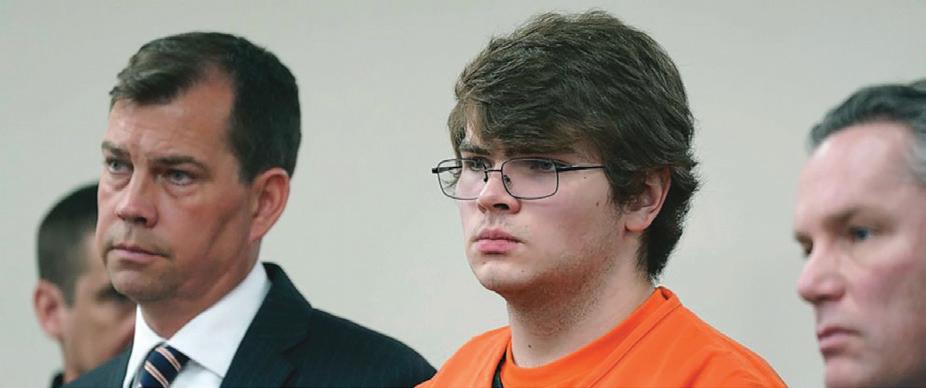
“You killed my sister,” Barbara Massey screamed out at Gendron.
“I will hurt you so bad. I’m not gonna be nice. Kat was my sister. I want to personally choke you out.”
She chastised the murderer, telling him, “You don’t know a damn thing about Black people. We’re human. We like our kids to go to good schools. We love our kids. We never go to no neighborhoods to take people out.”
Immediately, an unidentified man wearing a gray running suit leaped toward Gendron, prompting authorities to rush the shooter out of the courtroom.
After everyone returned to the courtroom, Judge Susan Egan of Erie County remarked about the tense situation, acknowledging the pain experienced by the victims’ families.
“We must conduct ourselves appropriately because we are all better than that,” Egan said.
Gendron then offered an apology and acknowledged his crime.
“I shot and killed people because they were Black,” he said. “I believe what I read online and acted out the hate and now I can’t take it back. I wish I could,” he lamented.
Last May, Gendron traveled to Buffalo where he admittedly targeted a specific Buffalo zip code that he’d determined was all-or-mostly-Black. He entered the Tops Supermarket and commenced his
WHO Gather for Urgent Meeting
Over
racially charged massacre.
A document he previously posted online championed the bigoted so-called “replacement theory,” so Gendron decided to kill as many African Americans as possible.
Egan sentenced Gendron to life in prison.
“There is no place for you or your ignorant, hateful and evil ideologies in a civilized society,” Eagan told Gendron.
““There can be no mercy for you, no understanding, no second chances. The damage you have caused is too great, and the people you have hurt are too valuable to this community. You will never see the light of day as a free man ever again.”
Gendron also faces 27 federal charges, including murder and hate crimes. If convicted of those charges, he could get the death penalty.
Outbreak of Virus Deemed among Globes
Deadliest Disease Has No Cure
By Stacy M. BrownNNPA Newswire Senior National Correspondent
The World Health Organization held an “urgent meeting” on February 14 to discuss the new Marburg outbreak in Equatorial Guinea and possible vaccine and treatment candidates.
The organization said it would send teams to the affected areas and send experts in epidemiology, case management, infection prevention, lab work, and risk communication to help with the national response.
Matshidiso Moeti, the WHO’s regional director for Africa, said, “Marburg is very contagious.”
Due to the Equatorial Guinean government’s prompt and decisive action in confirming the disease, “emergency response can get to full steam quickly” to save lives and end the virus as soon as possible, Moeti stated.
This week, WHO officials confirmed that the Marburg virus was first found in the west African country, where it has already killed at least nine people.
Previously, in 2017, health officials confirmed a few cases of Marburg in Ghana.
Despite being what the Centers for Disease Control and Prevention calls “a very rare disease in people,” Marburg has the potential to spread, and when it occurs, it can be fatal, officials warned.
Hemorrhagic fever caused by the Marburg virus is
highly contagious, the CDC said.
The RNA virus that causes it belongs to the same family as the Ebola virus, Filoviridae.
Both diseases are incredibly uncommon but can cause widespread epidemics with devastating effects.
In previous outbreaks of Marburg, the fatality rate ranged from 24% to 88%, depending on the virus strain and the quality of case management.
People who worked in mines and caves with colonies of Rousettus bats were likely the first to be infected with Marburg because of their prolonged exposure to the virus.
Unlike COVID, officials noted that the disease isn’t spread through the air.
Instead, it rapidly spreads from person to person through contact with infected blood, saliva, or urine, as well as contaminated surfaces and objects.
Family members and healthcare providers remain at risk even after a patient has been buried, as the disease can live on for some time in the body.
In 1967, the disease was found after researchers in Marburg, Germany, Frankfurt, Germany, and Belgrade, Serbia, got sick.
According to the WHO, symptoms like high fever, severe headache, chills, and malaise can appear “abruptly.”
Among the most frequently experienced signs and symptoms are aches and pains in the muscles.
Some of the others are jaundice, nausea, abdominal pain, and diarrhea. On day five, the CDC says a non-itchy rash may appear on the chest, back, or stomach.
CDC officials warns that many of the symptoms of Marburg “can be difficult” to diagnose in a clinical setting because they are shared with other infectious diseases like malaria, typhoid fever, and Ebola.
Death usually happens 8–9 days after the disease starts.
Initially, the victim experiences lots of blood loss, bleeding, and problems with multiple organs.
According to the WHO, those affected have a “ghostlike” appearance due to their lack of facial expression and extreme listlessness.
There are currently no approved vaccines or antiviral treatments to combat the Marburg virus.
Rehydration through oral or intravenous fluids, maintaining adequate oxygen levels, employing drug therapies, and treating specific symptoms as they arise are all examples of supportive care that can increase the likelihood of survival.
Though no treatments have been proven in clinical trials, some health experts have suggested that Ebola drugs, like those used for the virus, could be effective.
The CDC says that making people more aware of the disease can help stop and control it.

Health officials noted that some “experimental treatments” for Marburg have been tested on animals, not humans.
According to the WHO, at least nine people have died this week, and 16 have been diagnosed in the western KieNtem province.
“We’re still digging into this,” the WHO said.
The organization confirmed it had sent advance teams to the affected districts to “trace contacts, isolate, and provide medical care to people showing symptoms of the disease.”
There are also documented cases in Uganda, Ghana, the Democratic Republic of the Congo, Sierra Leone, and South Africa. According to the Health Ministry of Angola, the largest outbreak in 2005 killed more than 350 people.
“The virus is not known to be native to other continents, such as North America,” the CDC wrote in a release.
“Further investigations are ongoing. Advance teams have been deployed in the affected districts to trace contacts, isolate, and provide medical care to people showing symptoms of the disease,” the health body said.
This week, WHO officials confirmed that the Marburg virus was first found in the west African country, where it has already killed at least nine people.
Bust of Racist Former Supreme Court Justice Removed from U.S. Capitol
By Stacy M. Brown NNPA Newswire Senior National Correspondentsaid when he and fellow Maryland Rep. Steny Hoyer introduced the measure in 2020.
News Observer
The Valley’s
The Observer Group Newspapers reserves the right to publish views and opinions that may not necessarily reflect those of the staff and management are soleley the product of the responsible individuals who submit commentaries published in these newspapers. Letters, articles and comments appearing in the Observer Newspapers reflect the opinions of the contributor and do not constitute the opinion or endorsement by The Observer Newspapers or its staff. The Observer Group Newspapers assumes no responsibility for photographs, articles, letters, press releases and unsolicited materials. Decisions as to the editiing and publishing of materials are at the discretion of the Publisher and Editors. All rights are reserved on materials accepted for publication unless otherwise specified.
The Observer Group Newspapers of Southern California, Inc.: Los Angeles News Observer, Bakersfield News Observer, The Valley’s News Observer
The Valley’s News Observer 6060 Center Drive Floor 10, Los Angeles, CA 90045 Mailing Address: PO Box 2341, Bakersfield, Ca. 93303 Phone (661) 324-9466 FAX (661) 324-9472
General Info: observernews@gmail.com Advertising: observeradvertising@gmail.com
Online: www.ognsc.com
The bust of Roger Taney, the racist justice who wrote the infamous 1857 Dred Scott decision that said African Americans were not citizens, has been removed from the United States Capitol.
The removal is the result of an effort led by U.S. Sens. Ben Cardin and Chris Van Hollen of Maryland and U.S. Rep. Steny Hoyer of New York.
Last month, the U.S. House passed a bill ordering the removal of Taney’s statue.
The bill declared that Taney’s actions “renders a bust of his likeness unsuitable for the honor of display to the many visitors to the Capitol.”
The Dred Scott decision defended slavery and denied citizenship to African Americans.
Earlier, the Senate unanimously passed the same bill and later President Joe Biden signed it into law.
The legislation directed the Joint Committee of Congress on the Library to remove the statue, which sat inside the entrance to the Old Supreme Court Chamber in the Capitol.
Officials decided to replace Taney’s statue with one of Thurgood Marshall, the high court’s first Black justice.
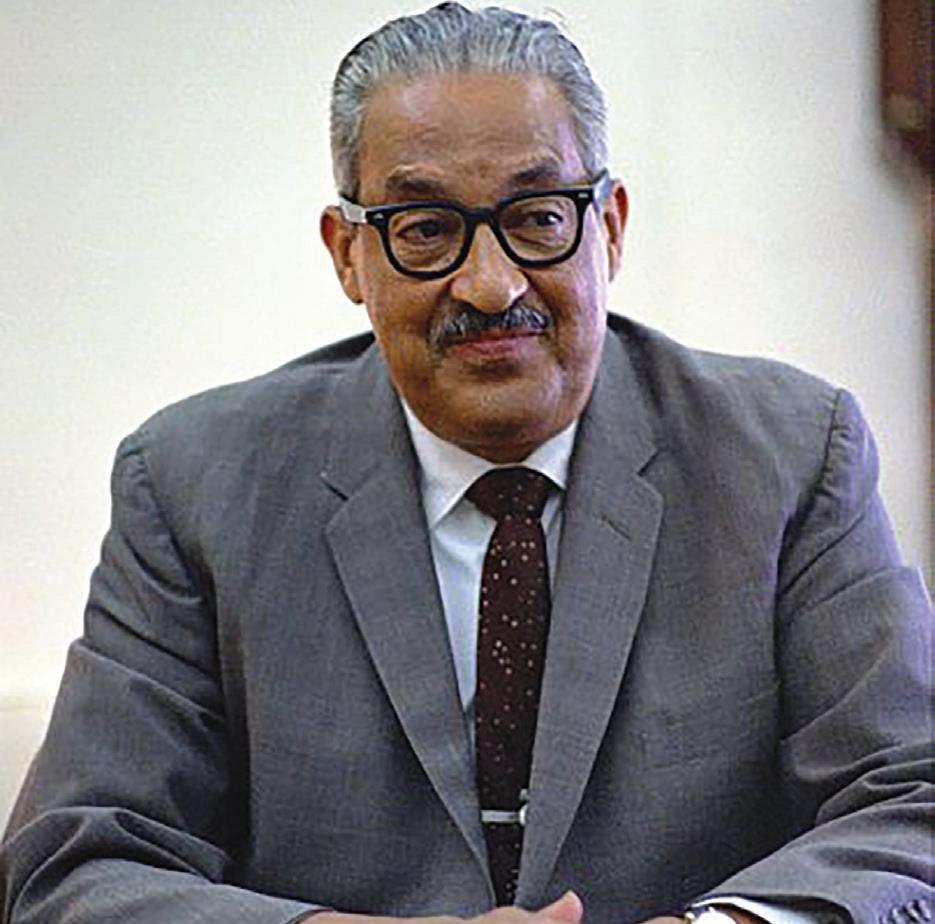
“The Dred Scott v. Sanford Supreme Court decision is a stain on our country’s history, and it was made under the Taney Court,” Congressman David Trone (D-Maryland)
“It’s time for us to remove this statue and denounce the institutions of slavery and racism once and for all. They have no place in the United States Capitol or anywhere in our country.”
Hoyer added that a bust of Taney should not be displayed in a place of honor in the U.S. Capitol.
“In Maryland, we made the decision to remove a statue of Taney from the State House grounds, reflecting his shameful contribution to the evil system of slavery and its defense, and we ought to do the same here,” Hoyer reflected.
“We are better than this, as our late colleague Elijah Cummings would say. It is time to make it clear to visitors from across our nation and from abroad that America celebrates champions of inclusion and equality, not proponents of hate and injustice.”
The bill states that “while the removal of Chief Justice Roger Brooke Taney’s bust from the Capitol does not relieve the Congress of the historical wrongs it committed to protect the institution of slavery, it expresses Congress’s recognition of one of the most notorious wrongs to have ever taken place in one of its 19 rooms.”
Wilson Picks Up Baton to Remove Slavery Language From California’s Constitution
Continued from page A1
“I am introducing this legislation because in every position of leadership (I’ve held) from (parks) commission to councilmember, from vice mayor to mayor, and now a state legislator; one of my responsibilities was, and is, to end systematic racism and root out discrimination,”
Wilson said on Feb. 15 at the State Capitol.
Wilson added, “We only make up 6% of the overall (California) Black population but we make up 28% of our incarceration population. The allowance of slavery in our prisons disproportionately impacts Black people.”
Article 1, Section 6 of the California Constitution currently allows involuntary servitude as a means of punishing crime. U.S. Rep. Sydney Kamlager (DCA-37) authored ACA 3 in 2020 as a California State Assemblymember.
Kamlager said involuntary servitude is “forced labor.”
“By removing this language from our Constitution, we are moving our state into the 21st century and taking steps to ensure that no Californian is ever put in a position of involuntary servitude again,” Kamlager said last year.
On June 23, the California Senate rejected ACA 3 with a 21-6 vote. It fell short of the two-thirds vote requirement, 27 or more, needed to move the bill to the ballot as a proposition for Californians to decide its fate. June 30, 2022 was the last day ACA 3 could have gained the votes it needed to have been placed on the 2022
November General Election ballot. It was not heard on the Senate floor that day. Five Republicans and one Democrat, Steve Glazer (D-Orinda), voted against the amendment.
“Slavery was an evil that will forever be a stain on the history of our great country. We eliminated it through the Civil War and the adoption of the 13th Amendment,” Glazer said in a statement. “Involuntary servitude – though lesser known – also had a shameful past. ACA 3 is not even about involuntary servitude – at least of the kind that was practiced 150 years ago. The question this measure raises is whether or not California should require felons in state or local jails and prisons to work.”
“I feel like this is something that not only needs to get done but must get done,” Parthas said during the Abolition Today podcast. “How can you talk about freedom, reparations, economic equity, equality in law and education while state slavery is still legal?”
Brown wrote the language in ACA 3 while he was in prison. He was released in 2021 after serving a 24-year sentence. The language of the bill was brought to the attention of Kamlager by Sacramento activist Jamilia Land.
Land is a member of the Anti-Violence Safety, and Accountability Project (ASAP), an organization that advocates for prisoners’ rights. Wilson said she was “proud to carry on the work” of Brown and Kamlager and ensured that she is committed to striking the word slavery out of
the United States constitution.
“This constitutional amendment is now a national movement,” Wilson said.
The chairperson of the California Legislative Black Caucus (CLBC), Wilson was the first Black female Mayor to serve in Solano County. First elected to the Suisun City Council in 2012, she served as Vice-Mayor for six years before winning the mayoral race in 2018.
Wilson was sworn into office to represent the 11th Assembly District after a special election last April following the resignation of former Assemblymember Jim Frazier. She serves as the assistant Majority Whip and is chair of the Select Committee on Transportation and Emergency Preparedness.
Wilson’s has the support of several statewide organizations in favor of removing the involuntary servitude clause: the Anti-Recidivism Coalition, Legal Services With Prisoners With Children, All Of Us Or None Of Us and the Anti-Violence, Safety, and Accountability Project. Sisters Warriors Freedom Coalition, and Communities United for Restorative Youth Justice are sponsors.
“California was founded as a free state,” Wilson said.
“There is no room for slavery in our constitution. It is not consistent with our values.”
Fox Pit Reporter Sims a Symbol of NASCAR’s Diversity Goals
By DAN GELSTON AP SportsWriter DAYTONA BEACH, Fla. (AP) – When Josh Sims reports on NASCAR this season, the stock car series these days -- from the garage to the grandstands to top brass -looks more like him.
Yes, Sims takes pride in the fact that he will become the first Black pit reporter for the Daytona 500 and that his rapid rise at Fox has made him one of the primary faces of the network's NASCAR coverage.

More than that, Sims sees that NASCAR may finally be running out of unconquered firsts for people of color. For women. For any minority who perhaps has experienced an uneasy relationship with a series founded in the South 75 years ago, a generation before the civil rights era.
Sims' journey from NASCAR novice through a sports anchor gig in Charlotte, North Carolina, that sparked his passion in the sport had led to his biggest assignment yet: pit reporting as a Black man from one of auto racing's signature events.
“I never set out to be a first,'' the 35-year-old Sims said. “I never set out to make history. I just wanted to be the best at what I was doing, whether it was hosting or reporting. At the same time, I kind of understand the platform and what it means for me to be doing this.''
Sims has a full workload this season. He is the Cup Series pit reporter, teams with Regan Smith as an Xfinity Series reporter and is part of the host rotation for the FS1 show “Race Hub.'' And this season, he wants to share the stories on what he sees at the track beyond the in-race reports and fantastic finishes. Minorities may not necessarily become the dominant demographic for the series, but they can certainly grab a larger share of the marketplace.
“I think if more people out there saw it, saw people that looked them, instead of just driver, crew chief, you might be more inclined to feel like, hey, I feel a little more comfortable going to the track,'' Sims said. “Getting that out there might help in terms of more people coming to the track and getting more different faces to the stands. It's not necessarily about getting more people in, it's showing what you already have.''
It was, of course, a very low bar but the garage and grid and fans certainly appears to be more diverse now than before 2020 when NASCAR banned the Confederate flag from its tracks and properties. NASCAR is still overwhelmingly white, but NASCAR President Steve Phelps isn't exaggerating when he says you notice the change when walking through the garage.
“I think the events of 2020 allowed the sport to get younger and more diverse,'' he said at his state-of-the sport address in November.
Among the notable achievements: Jusan Hamilton, who last year became the first Black race director in Daytona 500 history, will do it again this season. Amanda Oliver, a Black woman, negotiates high-profile deals as NASCAR's senior vice president. John Ferguson, a Black man, is the chief human resources officer.
Owners now include Pitbull and Michael Jordan, whose team features Bubba Wallace, the Black driver who prompted the flag ban. Rising stars in the developmental
series include Rajah Caruth, a 20-year-old graduate of the “Drive for Diversity'' program.
Phelps said NASCAR was committed to strengthening ties to various programs that can attract a broader fan base, from Boys & Girls Clubs to “some of the other areas we have from a partnership standpoint that really speak to what's happening in the African American community, what's happening in the Hispanic, Latino community (to) what's happening in the LGBTQ community.''
While the frequently toxic nature of social media makes it easier for haters to reach Sims and others, he's a popular personality each weekend at the track.
“I never necessarily felt uncomfortable,'' he said. “You get stuff here and there in terms of messages that's emailed to you or sent to you but that's par for the course if you're
a minority in the sport, a woman in the sport, even white drivers get stuff like that. But for every one or two of those, I get a lot more stuff from people excited that I'm here. You know, focus on the good.''
Raised in East Brunswick, New Jersey, Sims is a Villanova graduate who followed the Wildcats in NCAA Tournament games in 2009 and remained a fan of most Philly teams.
“I grew up in Jersey, so not exactly NASCAR country,'' Sims said. “Growing up, you know the Jimmies and the Dale Seniors and the Tony Stewarts and everybody but it wasn't something I followed week in and week out.''
His interest in NASCAR picked up in 2015 when he moved to Charlotte and hosted a pre-race show on the local Fox affiliate. Sims covered his first Daytona 500 in
2016 when Denny Hamlin nipped Martin Truex Jr. in the closest finish in race history.
“I was like, I am all in,'' Sims said.
Charlotte can feel like a small town for a city and Sims kept bumping into friends and contacts in NASCAR. Fox Sports executives hired Sims in 2021 as a reporter for their slate of NASCAR shows. He also became the first Black pit reporter in any NASCAR series, for Trucks races.
“I kind of hope that young people that look like me, can see me doing it and now recognize that it's possible,'' Sims said. “I hope I can kind of blaze a trail for them to one day say, hey, because Josh Sims did it, I can do it, too. And that's what's important.''
Rap Research Lab Looks at the Artistry of Hip-hop
By LAWRENCE BURNEYThe Baltimore Banner
BALTIMORE (AP) – When you step into the gallery at University of Maryland, Baltimore County's Fine Arts Building, one of the first things you see is a large multicolored graph on the wall. On it are the names of world-class rappers such as Jay-Z, 50 Cent and Lupe Fiasco in company with visual artists who've accomplished immortality through their work: Pablo Picasso, Jean-Michel Basquiat, Rembrandt. Circular nodes surround the names with lines connecting them to other familiar figures such as Ja Rule, J. Cole, Andy Warhol, Vincent van Gogh and A$AP Rocky, whose names are also incapsulated in circles of different colors. The network graph shows the relationships between rappers and the painters they've name-dropped in their music, the larger nodes indicating who's been mentioned the most throughout hip-hop history.
The mentions “could be for a number of reasons,'' said Tahir Hemphill _ whose “Picasso, Baby!'' piece is part of a larger exhibition called Rap Research Lab _ as he gives me a tour through the space. “It could be because people like Pablo Picasso, or it could be a shorthand for mastery and wealth. But also in terms of alliteration and rhyme, it's kind of easy to rhyme. I mean, `I'm trying to cop those colossal-sized Picassos' _ it's easier to rhyme compared to other artist's names.''
Hemphill, 50, whose work is at the intersection of technology, art and research _ often through the lens of hip-hop culture _ is at the tail end of a two-year fellowship in UMBC's Department of Visual Arts. Rap Research Lab, which opened recently, is an ever-evolving culmination of his 16year commitment to making interactive art from his interpretations of information. Along with collaborators, he develops systems that produce invaluable data about rap lyrics.
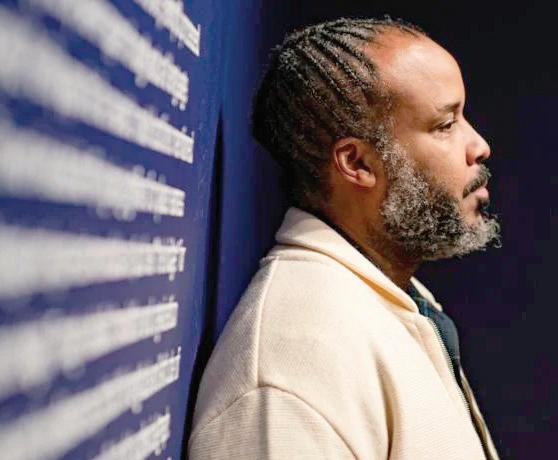
“Picasso, Baby!'' was created in 2014 and named after a Jay-Z song that came out the year before, in which the rapper relishes in the luxurious aspects of his life _ most notably, owning art from the likes of Jeff Koons, Mark Rothko, Picasso and others. It marked a significant shift in hip-hop in
which rappers started to look at expensive art as a way to flex their wealth or taste, in addition to the old reliables like jewelry and cars.
“I already started the update and the original list for painters (mentioned in rap songs) was maybe like 50 or 60
in 2014,'' Hemphill says. “And the new list of painters is like 200.'' The beauty of Rap Research Lab is that, as time goes on, the art will inevitably change shape as more data comes in.
Elsewhere in the show is “Maximum Distance,
Minimum Displacement,'' displaying 3-D renderings of where rappers travel in their work. During a residency at Carnegie Mellon University in 2017, Hemphill and six others used lyrics from rappers like Missy Elliott, Drake and Nas to track the locations (cities, neighborhoods, their favorite food joints) mentioned in their songs. From there, the team found the coordinates of said locations and developed spherical graphs to add dimension.
“At Carnegie Mellon University, they gave me a tour of the digital fabrication line. So they had laser cutters, they had large-format printers, they had CNC routers. And we were walking down this hallway and it was a glass wall and I looked and I saw this 15-foot robot, industrial robot, was just sitting there,'' he remembers with a smile. “And I'm like, `Yo, what's up with this?' They said, `Oh, that's our robot arm,' and I was like, I don't know what I'm going to do with it but I'm not leaving here without touching it.''
Hemphill and team developed a light stylus for the robot arm and programmed it to trace coordinates of the rappers' favorite places to create figures. Analog photos and video documentation of the process are also on view at the show.
Other works in Rap Research Lab include footage from an internet-sourced 1990 interview of rising New York rappers in which Hemphill takes note of the shoutouts each artist gives when they come up to the mic. There's an encased vinyl collection of albums that served as inspiration while Hemphill put the show together. And there's his oldest project, 2007's rap score cards, which took selected tracks and gave them grades based on the depth of the rapper's vocabulary and suggested what level of education a person needed to fully comprehend what the song was about.
Rap Research Lab's power is that it provides a plethora of entry points for those interested in looking at hip-hop through data analysis, and the pieces encourage you to think about how your own favorite music would physically manifest. And you don't just have to come to the show at UMBC to get those tools (even though you should still pay a visit).
Rap Almanac is an online database that Hemphill has been fine-tuning for over a decade. It's the easiest way to look for lyrics out of particular regions and in different languages. And unlike what can be seen at UMBC, the website is up to date with new music.
“When I did those (rap score) cards, I was like, `This is a cool little project. I'll do a poster. I'll do some cards. I'll move on to the next thing.' And that hasn't happened,'' Hemphill said of the research lab's continued growth. “So part of this project is to bring people together to have those conversations.''
Black Taxpayers are Targeted for Audit More than Others
By Stacy M. Brown NNPA Newswire Senior National CorrespondentAccording to Stanford RegLab, Black taxpayers receive IRS audit notices at least 2.9 times more frequently than non-Black taxpayers and possibly as much as 4.7 times more often.
The new study included research by Daniel E. Ho, the William Benjamin Scott and Luna M. Scott Professor of Law at Stanford Law School, faculty director of the Stanford RegLab, a senior fellow at the Stanford Institute for Economic Policy Research, Hadi Elzayn, a researcher at the Stanford RegLab, Evelyn Smith, Ph.D. candidate at the University of Michigan, and Arun Ramesh, a predoctoral fellow at the University of Chicago; Jacob Goldin, a professor of tax law at the University of Chicago; and economists in the U.S. Department of Treasury’s Office of Tax Analysis.
The researchers concluded that the disparity “is unlikely to be intentional on the part of IRS staff.”

The team’s research showed that a set of internal IRS algorithms causes racial differences in audit selection. Goldin compared them to the recipe for Coca-Cola: “It’s completely secret.”
To better understand this audit selection bias, the research team modeled the racial impact that various alternative audit selection policies might have.
The result showed how the IRS could change its secret algorithm to make it less unfair to people of different races.
“The IRS should drill down to understand and modify its existing audit selection methods to mitigate the disparity we’ve documented,” Ho said.
“And we’ve shown they can do that without sacrificing tax revenue.”
Although there have been long-standing questions about whether the IRS uses its audit powers somewhat, Ho said it was challenging to study because tax returns are private.
The IRS’s approach to audit decisions was confidential.
That changed when, on his first day in office, President Joe Biden signed Executive Order 13985. This order requires all federal agencies to examine how their programs affect racial and ethnic equity.
To apply that order to the IRS tax return audit program, economists at the Treasury Department worked with the Stanford RegLab team to analyze more than 148 million tax returns and about 780,000 tax returns for 2014. The RegLab team used anonymous data to do the analysis.
Even with all that information, the research team found that tax returns do not ask for a person’s race or ethnicity.
So, the team adapted and improved on a state-ofthe-art approach that uses first names, last names, and geography (U.S. Census block groups) to predict the probability that a person identifies as Black.
And they confirmed their racial identification results using a North Carolina sample of voter registration records. In that state, until recently, when people registered to vote, they had to check a box for race and ethnicity.
After finding that Black taxpayers were 2.9 to 4.7 times more likely to be audited than non-Black taxpayers, the team looked at why this might be the case.
They suspected that the problem lay with an IRS
algorithm’s use of the Dependent Database, which flags a potential problem and generates an audit letter to the taxpayer. That instinct proved correct in that most racial differences were found in so-called “correspondence” audits. These audits are done by mail rather than in person.
The team also found that the IRS audits people more often who claim the Earned Income Tax Credit (EITC). The EITC helps low- and moderate-income people.
But claiming the EITC only explains a small percentage of the observed racial disparity.
The largest source of disparity occurs among EITC claimants. Indeed, Black taxpayers accounted for 21% of EITC claims but were the focus of 43% of EITC audits.
The racial disparity in audit rates persists regardless of whether EITC claimants are male or female, married or unmarried, raising children, or childless.
But it is most extreme for single male taxpayers claiming dependents (7.73% for Black claimants; 3.46% for non-Black claimants) and for single male taxpayers who did not claim dependents (5.66% for Black; 2% for nonBlack).
Perhaps the most striking statistic is this: A single Black man with dependents who claims the EITC is nearly 20 times as likely to be audited as a non-Black jointly filing (married) taxpayer claiming the EITC.
Although the team does not know precisely what algorithm the IRS uses to choose audits, they thought of several possible reasons for high audit rates.
First, they tried an “Oracle” approach. They used a dataset called the National Research Project (NRP).
Because each tax return in this dataset was subjected to a line-by-line audit, the amount of underreported tax liability is known.
So the researchers looked at what would happen if the IRS selected taxpayers based on the known amount of underreported tax in the NRP dataset.
The result: The racial difference in audit selection flips.
The IRS would audit more non-Black taxpayers than Black taxpayers to catch the most underreported income tax. The team also used the NRP dataset to train a model to predict the likelihood that a taxpayer has underreported income and the magnitude of a taxpayer’s underreporting for the entire 2014 dataset.
They found that an approach focused just on the likelihood that there’s underreporting of at least $100 would result in auditing more Black taxpayers (as was observed).
By contrast, focusing on the magnitude of underreporting (the amount of money unpaid by a taxpayer) would yield a result much closer to the oracle: More non-Black taxpayers would be audited than Black.
“The choice to focus on whether there is underreporting, as opposed to the magnitude of underreporting, is connected to broader structural sources of economic inequality and racial justice,” Smith said.
Because far more Black taxpayers have lower income, they have less opportunity to underreport substantial amounts of income, the researchers concluded.
By contrast, Smith said, “focusing audits on the amount of underreported income will disproportionately
end up focusing on higher income individuals who are less likely to be Black taxpayers.”
Finally, the team wondered if the racial disparity in audits springs from IRS and congressional concerns about refundable tax credits, including the EITC and several others. When someone claims one of these social security tax credits, they receive a refund even if they did not pay any taxes. And some in government think it’s more important to avoid paying money to someone who claims it inappropriately than to collect all the tax dollars due from someone engaged in some other form of tax evasion.
To test the hypothesis that this approach would have a disparate impact on Black taxpayers, the team examined what would happen if the IRS focused audits specifically on the underreporting due to over-claiming of refundable tax credits (the EITC as well as two others) rather than total underreporting.
Their findings: This policy would result in Black taxpayers being audited at rates like what the team observed in the 2014 data.
Seventy percent of IRS audits happen through the mail, and 50% involve EITC claimants.

The team found that correspondence audits of EITC claimants are easy to trigger compared to labor-intensive field audits, cost very little, and require minimal effort by IRS personnel.
Unfortunately, the burden of correspondence audits on EITC claimants is more likely to fall on lower-income individuals, whose tax returns are less complex and less likely to lead to litigation, according to a recent study by the same research team.
In their new work, the team found that additional aspects of the IRS audit selection process have a racially disparate impact in the United States.
For example, even among correspondence audits of EITC claimants, the IRS devotes fewer resources to auditing EITC returns with business income.
The team concluded suggested that it’s because it would be more expensive to audit EITC returns with business income (about $385 per audit compared to $29 per audit for EITC claimants with no business income), Elzayn said.
And the team found this cost-saving measure has a disparate impact on Black taxpayers, who make up only 10% of EITC claimants reporting business income but 20% of EITC claimants who don’t report business income.
Yet even if IRS resource limits explain some of the racial disparities the team observed, they don’t explain all of them.
“Even holding fixed how many audits are devoted to EITC claimants who report business income, we still observe racial disparities,” Elzayn said.
The study’s authors have not made any formal recommendations for making the IRS audit selection algorithm more just.
Instead, they have written about the possible effects of alternative policies. This allows the IRS to reduce the racial impact of its system of choosing auditors.
These include predicting and focusing on the magnitude of taxpayers’ underreported income rather than just the likelihood of it; using IRS resources to audit more complex returns rather than focusing only on the simpler ones that are cheaper to audit; and viewing dollars as equal whether they are to be paid in refundable credits or received in taxes.
Before Biden signed the Racial Justice Executive Order that engendered this research project, the IRS needed more impetus and the ability to do that.
Now that they know the equity implications of how they select audits, Ho hopes they will tweak their confidential audit selection algorithm.
“Racial disparities in income are well known, and what the IRS chooses to focus on has big implications for whether audits complement, or undercut, a progressive tax system,” Ho said.
algorithm to make it less unfair to people of different races.
According to Stanford RegLab, Black taxpayers receive IRS audit notices at least 2.9 times more frequently than non-Black taxpayers and possibly as much as 4.7 times more often.
It is a Wrap for the 31st Annual Pan African Film Festival

 By Ricky Richardson
By Ricky Richardson
Contributing Writer (Los Angeles, CA)
The second week in February is always a momentous occasion. If you were thinking Valentine’s Day, you were not far off the mark. Give yourself a star if you guessed the annual Pan African Film and Arts Festival. A large crowd of youth and young adults and adults, attended to view some world-class cinema from the African diaspora, February 9-20, 2023, at the Cinemark Baldwin Hills Crenshaw XD, with the ArtFest, a showcase of African art and crafts from around the world, on display, on both floors of the adjacent Baldwin Hills Crenshaw Plaza. You maybe already are experiencing withdrawal symptoms such as the camaradie of being in theaters again to enjoy some excellent cinema from across the diaspora. No need to despair there is hope at the end of this article.
The film festival got underway with a star-studded Red Carpet Opening Night Gala held at the Director’s Guide of America. The evening included a screening of the highly anticipated feature, Chevalier, inspired by the incredible story of composer Joseph Bologne, Chevalier de Saint-Georges. The film is about the son of an enslaved African woman and a French plantation owner, Bologne (Kelvin Harrison Jr. in a tour de force performance) rise to improbable heights in French society as a celebrated violinist-composer and fencer, completed with the ill-fated love affair and a falling out with Marie Antoinette (Lucy Boynton) herself and her court. Chevalier directed by Stephan Williams, writer and producer Stefani Robinson.
As part of this year’s Pan African Film & Arts Festival there are over 150 films from 40 countries, in 19 languages, including 50 World and North American premieres. Of the films selected for the festival, 39% are helmed by female, queer or non-binary filmmakers. The
the Black diaspora. A diverse, multi-cultural crowd perused the eclectic mix of original art to suit a range of personal tastes. The exhibition and sale include paintings, sculpture, ceramics, fashion, jewelry, home décor and African artifacts.
The theme of this year’s festival is 2023 PAFF Reimagined to inspire and appeal to a new generation of filmmakers and moviegoers. In celebration of Black History Month, the Pan African Film & Arts Festival (PAFF) and IKEA collaborated for the second year to create All Artists Have a Seat at the Table exhibition. In partnership with IKEA, world-renowned Black artist from PAFF created fine art with IKEA furniture as part of the All Artists Have a Seat at the Table exhibition. The goal is to establish, preserve and present “imaginative stories” – and to keep the expressions of Black art vibrant and alive. These artists were asked to create a visual representation of the rich history and culture that has shaped the Pan African Film & Arts for the past three decades using IKEA’s IVAR chairs and their INGO table.
The wonderful artists featured in the exhibition were Porter Ayayi Olanrewaju from Nigeria; Aziz Diagne from Senegal; PeQue Brown from America; Marvin Obasogie Aimiuwu from Nigeria; Sandra Zebi from Brazil; Yendi Serwaa from America; and Sylvia “Gbaby” Cohen from America.
Friday, February 10th, at the Baldwin Hills Crenshaw Plaza, PAFF ArtFest Opening Reception was held on the first floor in PAFF Institute (formerly Forever 21).

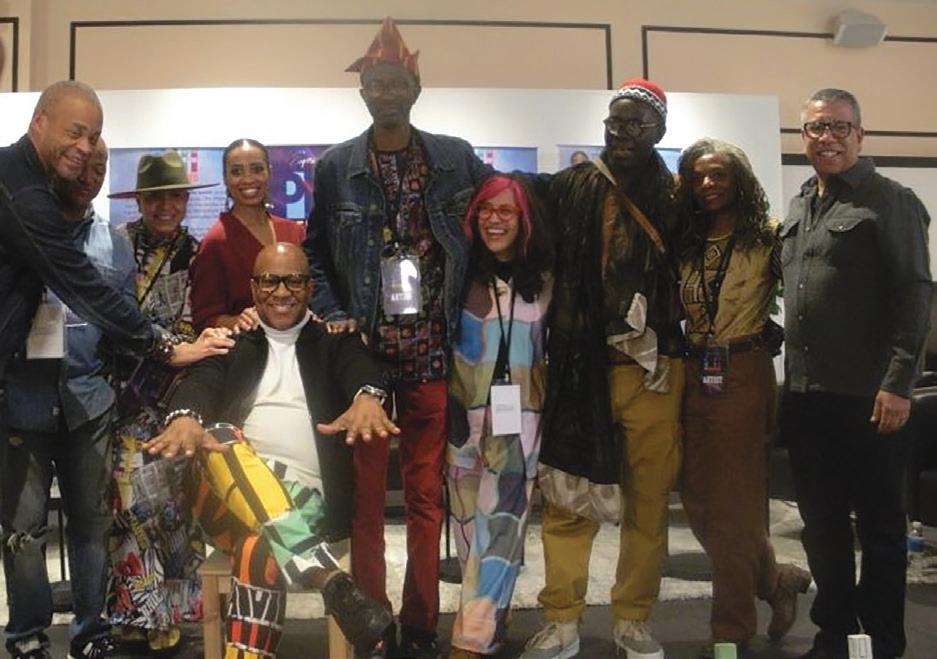
The opening of the PAFF ArtFest at the Baldwin Hills Crenshaw Plaza, IKEA presented a panel discussion about art, livable furniture with the artists featured in the exhibition, along with Andrew Alcantar, IKEA’s Communication & Interior Design Manager. Lauren MacKay served as moderator. The artists discussed their creative process and spoke about the chair that they designed and its title. A reception followed the discussion. Gloria Simington of Ms. Glo’s Catering showed up and showed out with her creative masterpiece of a Grazing table, a sumptuous display of colorful, delightful and delicious, edible art. Ms. Glo took the concept of a charcuterie display to another level.
PAFF ArtFest featured over 100 established and emerging fine artists and quality craftspeople from all over the world. With cultural aesthetic that is rooted in Africa, and its diaspora, featured artists presented their creative works using oil on canvas, plastic, wax, wire, leather & more.
Let the binge travel through the diaspora begin by way of cinema. Friday, a hilarious screening of What Had Happened Was… The Herbert and Cleofis was the first movie I saw. 12 years after completing his 1940’s screwball comedy featured film debut, director Bobby Huntley reunites with his cast to discuss the unreleased film that almost was. The audience and I enjoyed how the director was able to pivot from a featured film to a documentary film with material from his unreleased film. This would
be an excellent educational tool for first time filmmakers and those in film schools. This movie aligns with the film festival theme PAFF 2023 Reimagined-Experience a new story.
PAFF Institute featured many engaging, entertaining and educational panel discussions. Leading Ladies Crushing It is one of many panels taking place throughout the festival. Moderator Sheryl Underwood (The Talk) walked the Red Carpet with the panelist, Sonequa Martin-Green (Star Trek: Discovery); Tichina Arnold (the Neighborhood); Paula Newsome (CSI: Las Vegas); Meta Golding (Rabbit Hole); and Shinelle Azoroh (Swagger). Actress, New York Times Best Seller, Social Media Influencer, & host of YouTube Originals “Tab Time”, Tabitha Brown walked the Red Carpet after joining the kids at children’s fest for an up and close & personal meet & greet for autographs and pictures opportunities, resulting in memorial moments and priceless smiles. Santos- Skin on Skin: Seven- time Grammy nominated John Santos is a “keeper of the Afro-Caribbean flame.” The movie is rich in musical performances, Santos links rhythms of his ancestors to contemporary struggles of identity and social justice. The film consists of stellar musicians Eddie Palmieri, Omar Sosa, John Galloway and Orestes Vilató to name a few. The next great movie that I saw was Music is My Life-Joseph Shabalala and Ladysmith Black Mambazo. The remarkable story of the late Dr. Joseph Shabalala, the leader of South Africa’s multi-Grammy award-winning group, Ladysmith Black Mambazo. The film featured previously unseen archival footage and music and includes exclusive interviews with the Shabalala family, and many famous people, such as Oprah Winfrey, Paul Simon Whoopi Goldberg to name a few. The film celebrates the magnitude of Shabalala’s musical influence and his strong rooted musical traditions in the local styles of Isicathamiya and Mbude, a hidden gem of South African culture. This musical excursion capturing Joseph’s musical and spiritual journey illuminates how a young man from a rural village called Ladysmith in 1960’s South Africa, came to conquer sold-out shows and become a worldwide musical visionary. Teane Maseko, composer and one of the team members who worked on the film participated in a Q&A following the screening. This just in, Ladysmith Black Mambazo will be in Los Angeles next week, Friday, March 3rd, for a performance at the Walt Disney Concert Hall followed by a tour across the United States. This is a perfect time to see and hear this awesome group perform live in concert in an amazing concertMusicvenue.aficionados were out in force to view some engaging and entertaining screenings. Theatres were packed for Music is My Life- Joseph Shabalala and Ladysmith Black Mambazo; Born in Chicago; Fantastic Negrito: Have You Lost Your Mind; God Said Give “Em
that covered many aspects of the entertainment industry, special events and programs consisted of StudentFest; Saturday Morning Children’s Festival; PAFF SpokenWord; PAFF LOL-Comedy Night; Word Onna Street Live + Afterparty; Black Hollywood: Reimaging Iconic Movie Moments by Carell Augustus; Black on Black: Discussion and booksigning with Eboni K. Williams; Meet & Greet: Kountry Wayne; Senior Connections; Fashion Show and the Filmmaker’s Awards Brunch.
Drum Machines; Hargrove; Kansas City Dreamin’; Little Richard: I Am Everything; Santos- Skin to Skin. Attendees at the Pan African Film & Arts Festival enjoy a wide array of panels during the PAFF Institute
Additional highlights featured special presentations of Wayward Waters: Black Cinema & The Atlantic Overview in association with LACMA’s Aspect Ratio film education program. Stocker Street Creative (SSC) project in Baldwin Hill returned for a second year in a row as a platinum sponsor of the Pan African Film & Arts Festival. Stocker Street Creative Gallery and Salons held engaging industry panel discussions and screenings on the second floor of the Baldwin Hills Crenshaw Plaza. SSC is building a state –of-the-art creative space in the heart of Los Angeles’ black creative community where Black creative can tell their stories authentically. PAFF believes film and art can lead to a better understanding, and foster communication between people of diverse culture, races and ethnicities in an entertaining way while serving as a vehicle to initiate dialogue on the important issues of our times,” stated Marc Brogdon, head of Marketing at PAFF. Stay in the know. Visit https://www.paff.org
Heirs of Bruce’s Beach Finalize Sale of Property Back to L.A. County
Ray Harvey California Black Media
On Jan. 30, the heirs of Bruce’s Beach finalized the sale of the land they just reclaimed last year back to Los Angeles County for $20 million.
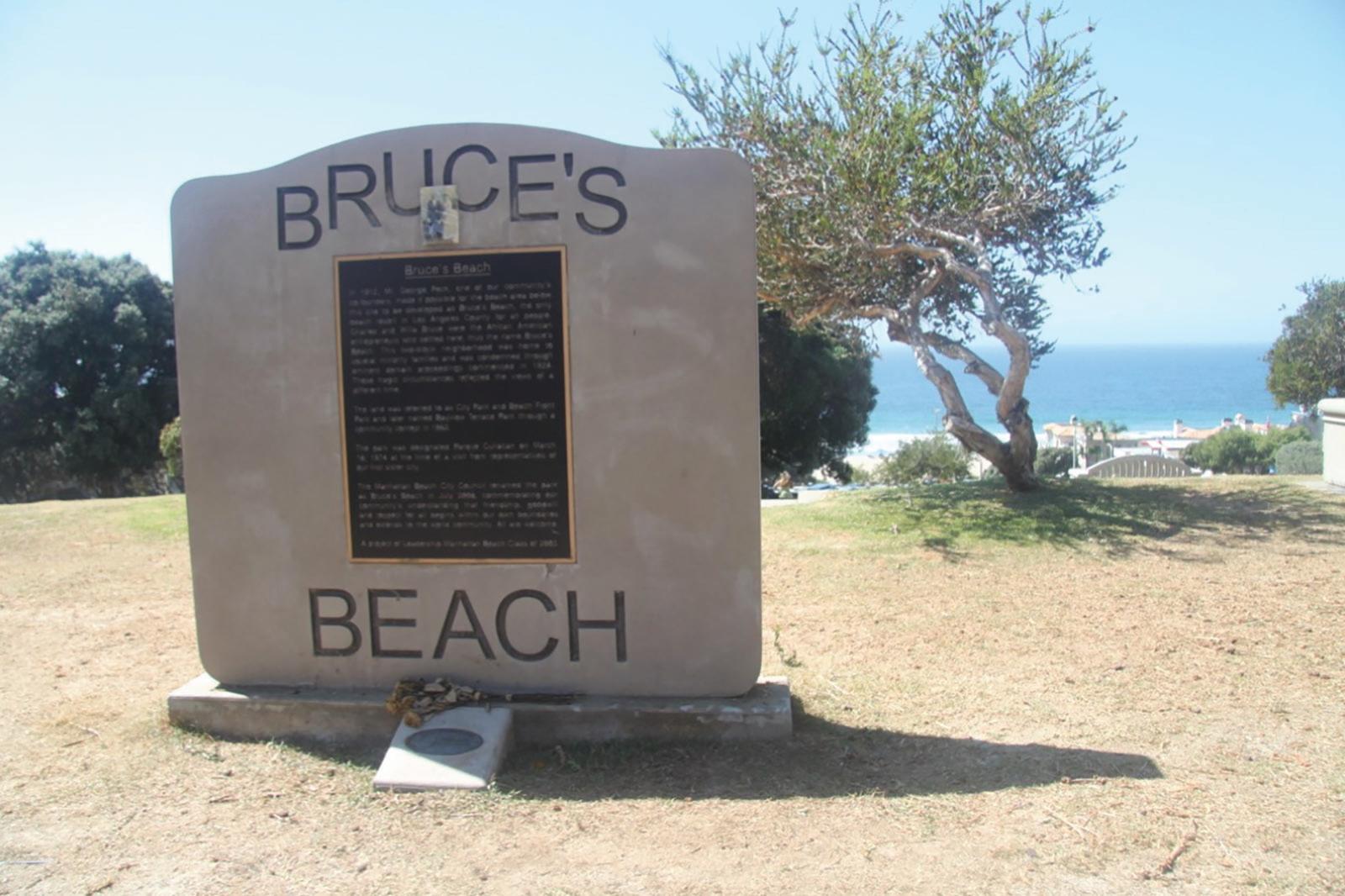
Antonio Moore, a Los Angeles attorney and cofounder of the American Descendants of Slavery (ADOS) movement, says the deal reached by the heirs of Bruce’s Beach “doesn’t seem to be at fair market value.”
In his Jan. 6 podcast, which can be viewed on Youtube, Moore said he crunched the real estate numbers of surrounding property in Manhattan Beach and claims that the land is worth more than the $20 million – the price at which the heirs of the controversial property were offered for the land.
The attorney said the option to sell back the land, which was first purchased in 1912 and illegally acquired by the city, is akin to the financial loss Black Americans have experienced over the decades due to “housing discrimination.”
“In essence, we are going to give them back the property but not assess any of the generational costs,” he said. “And then we (the county of Los Angeles) are going to create all types of limitations on the way they can access and use that property.”
Moore continued by saying, “The fact that this was sold back for $20 million should have everyone in an uproar. The fact that the (California) Reparations Task Force has literally said nothing about this is abject failure in my view.”
Moore said in his 37-minute podcast that no one really took the time to “contextualize” the agreement between the county and the Bruce family since the announcement was made. Houses and condos around Bruce’s Beach are priced at around “$3 or $4 million dollars,” he said.
According to Realtor.com, Manhattan Beach in Los Angeles County consists of five neighborhoods. As of Jan. 22, there were 57 homes for sale, ranging from $1.2 million to $22 million. As of July 1, 2022, 34,668 people resided in the beach town located about 30 miles southwest of Los Angeles. Of that number, 74.8% are White and 0.5% are Black, according to U.S. Census Bureau numbers.
“I am not here to attack this family,” Moore said of the Bruce family. “I am more so here to question how we got here.”
The Bruce Family’s attorney George C. Fatheree III told KBLA radio personality Tavis Smiley that the family was prompted to sell because it faced a long and drawnout process to get approval for development by the city of Manhattan and the California Coastal Commission.
“The return of the property and the ability to sell the property and take funds and invest it in a way that’s important to their lives represents an important opportunity for my clients to get a glimpse of that legacy that was theirs,” Fatheree said.
The disturbing story of Bruce’s Beach Park -- the location of the first West Coast seaside resort for Black beachgoers and a residential enclave for a few African American families -- has received worldwide attention. One hundred years ago, Manhattan Beach city officials seized Charles and Willa Bruce’s beachfront property through eminent domain, citing an “urgent need” to build a city park.
The use of eminent domain was the end result of segregation, intimidation, violence and threats from the Ku Klux Klan in Manhattan Beach. The plot of land that attracted Black people from all over the country was not developed for recreational use after it was forcefully taken from the Black owners.
On April 9, 2021, Los Angeles County Supervisor Janice Hahn announced the return of the land to the Bruce’s descendants. The Bruce’s purchased the real estate in 1912 for $1,225. The transfer of ownership of the land was able to be completed with the help of legislation authored by state
Sen. Steven Bradford (D-Gardena). Senate Bill (SB) 796 exempted the Bruce’s Beach property from state zoning and development restrictions and enabled the county to return the site to its rightful owners.
On Sept. 30, 2021, Gov. Gavin Newsom signed off on SB 796, allowing the Bruce family to retain property that has appreciated in value over the last century.
Two options sat on the table for the heirs. LA County was in line to lease the land for $413,000 per year. It also included an exchange to buy the land for as much as $20 million. The family took the latter.
After the news of the decision to sell the land back to the county broke, social media exploded with commentaries from the Black community – for and against the sale. Opinions on Twitter ranged from, “they got hustled,” the family “knew they’d sell back the property due to taxes,” “I wish they could have reached out to grass roots for direction and assistance,” “sad,” “unbelievable,” to “This was theirs to sell in the first place. Why are we acting like this was ours?”
Holly J. Mitchell, L.A. County Supervisor for the 2nd District, stated in a Jan. 3 press release that she was “proud” that the county and state addressed the “systematic racist acts that have cost Black families generational wealth.”
“I fully support the self-determination of Black people and families like the Bruce’s to decide what is best for their lives and legacy,” Mitchell stated. “I will continue to advocate for the Bruce family to be fully informed and prepared for the immediate and long-term implications of this sale.”
Considering the well-documented history of racism in housing and real estate that have affected Black Californians, Bruce’s Beach draws attention to other areas in the state where discriminatory laws or practices that have caused Blacks to be illegally displaced or to lose valuable property. Many of these incidents have been highlighted by the California reparations task force.
Examples include land once owned by Black pioneers in Coloma, where the Gold Rush started in 1848; the removal of African Americans from their homes in downtown Santa Monica; and Black community loss of property in Russell City, located between Hayward and Oakland.
“The return of Bruce’s Beach to the rightful heirs of Charles and Willa Bruce will continue to serve as an example of what is possible across the globe when you have the political will and leadership to correct the injustices of the past,” Mitchell added.
Bill Bans Police Canines for Arrests, Crowd Control
Edward HendersonCalifornia Black Media
Last week, Assemblymember Corey A. Jackson (D-Riverside) introduced Assembly Bill (AB) 742, legislation that would prohibit the use of police canines for arrests, apprehensions and crowd control.
The use of police canines, supporters of the legislation say, is a throwback to the darkest days of legal slavery, Jim Crow segregation – and a reminder of America’s history of racial bias, aggression and violence against Blacks and people of color. Jackson says he wants to end the “deeply racialized, traumatic and harmful practice.”
“Since their inception, police canines have been used to inflict brutal violence and lifelong trauma on Black Americans and communities of color,” said Jackson at a press conference held to announce the bill. “It’s time to end this cruel and inhumane practice and instead work towards building trust between the police and the communities they serve.”
The American Civil Liberties Union (ACLU) California Action, a co-sponsor of AB 742, echoed Jackson’s concerns. “The use of police canines has severe and potentially deadly consequences for bite victims, especially communities of color,” said Carlos Marquez III, Executive Director of ACLU California Action. “It’s time for California to take a stand and end this inhumane practice.”
Jackson says his stance on the use of canines in law enforcement is backed up by data. For him, it’s a “moral issue” as well.
“I let the data take me to where I need to go. And the data is clear that in some of the most consequential issues of our time right now – especially when it comes to the relationship between law enforcement and the African American community,” Jackson told California Black Media (CBM). “This was a no brainer for me. This is not a gotcha bill. Our own data in California shows that we have it wrong, and we have to fix it.”
“The fact that canines are harming people more than batons and tasers is astonishing to me. I would never have guessed that” added Jackson who says he has already read three reports on the topic.
The California/Hawaii (CA/HI) Conference of the NAACP, another cosponsor, acknowledges the bill’s historical importance. “Police canines have historical roots in slavery and have continued to be used as tools of oppression for Black, Brown, and other communities of color,” said Rick L. Callender, President of the CA/ HI NAACP. “With this bill, we can begin to shift and sever ties with the terrorizing past.”
AB 742 does not call for banning the use of police canines for search and rescue, explosives detection, and narcotics detection – all activities that do not involve biting.
“The use of a canine is sending a dog out that will inflict injury on a person before that person has been accused of a crime or formally convicted of one,” said Kat Carell, a member of the Sacramento Chapter of the ACLU. “So, you end up with lifelong disfigurement, or mental problems, or you could be killed before you have ever been in a court of
law and proven guilty of anything.”
Reaction to the introduction of the bill by police dog handlers and some law enforcement organizations -including the Western States Canine Association -- was swift, charactering the bill as misguided and going too far.
more non-lethal weapon law enforcement relies on to fight crime. Cloward, who owns a canine training business, told ABC news affiliate in Bakersfield that while dog bites can be harmful and “disfiguring,” they do not cause death.
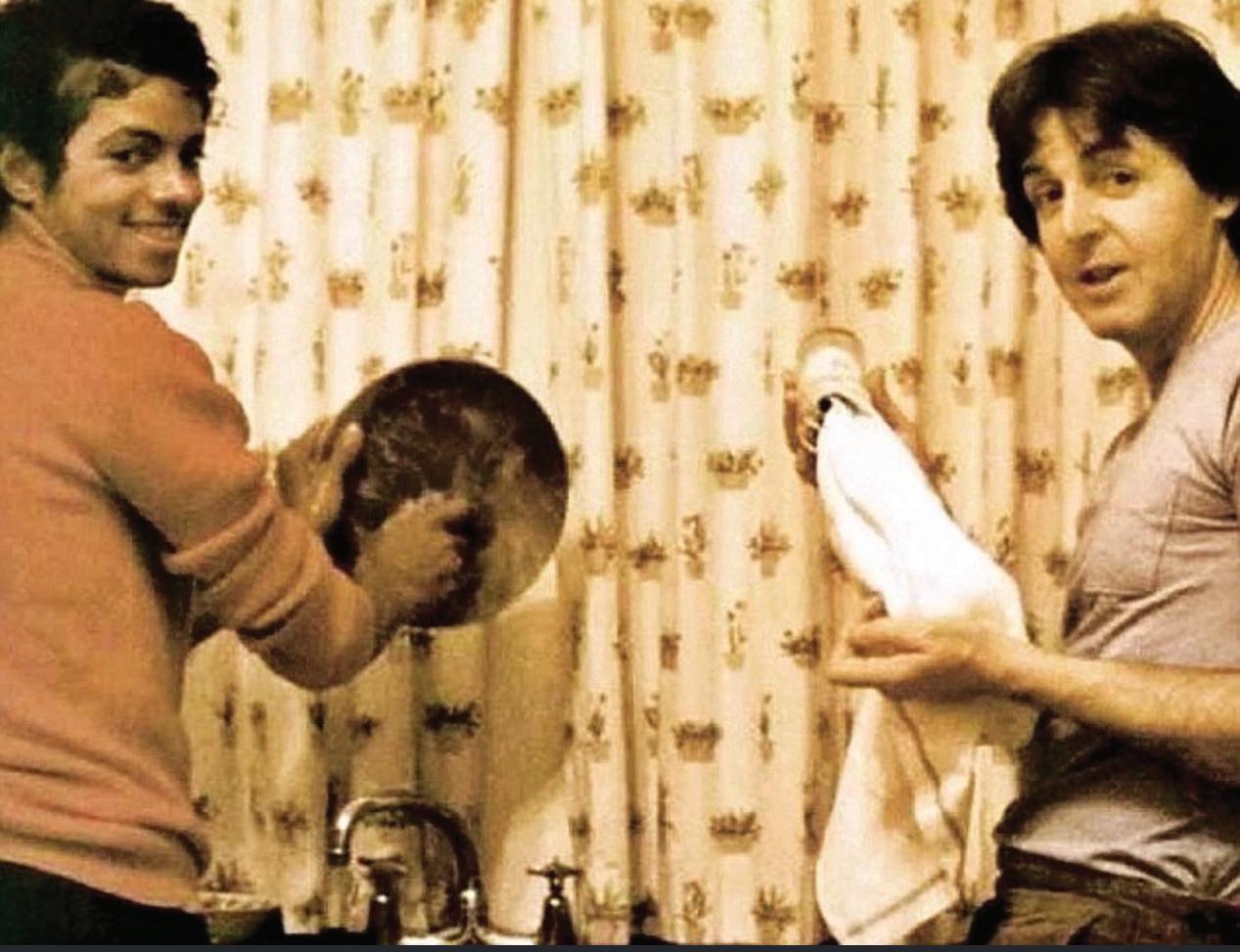
“Once you’ve deployed pepper spray, it’s been deployed. It’s gonna land. Once you use your gun, it’s gone,” he said. “Once you use a taser, it’s on its way. You’re not stopping it. The only thing you can stop is a K-9.”
Jackson was elected in November of 2022 to represent the 60th Assembly District. Before that, he served on the Riverside County Board of Education in 2020 and represented portions of the cities of Riverside, Moreno Valley, Perris, and the unincorporated community of Mead Valley.
Supporters say Jackson’s background in social work gives him a keen awareness and understanding of the microaggressions Black and Brown communities face.
AB 742 is one of many pieces of legislation Jackson has introduced (or plans to) that holds individuals and institutions accountable, creating room for even larger victories towards dismantling systematic racism. He calls the effort the ‘Antiracism Bill Package.’
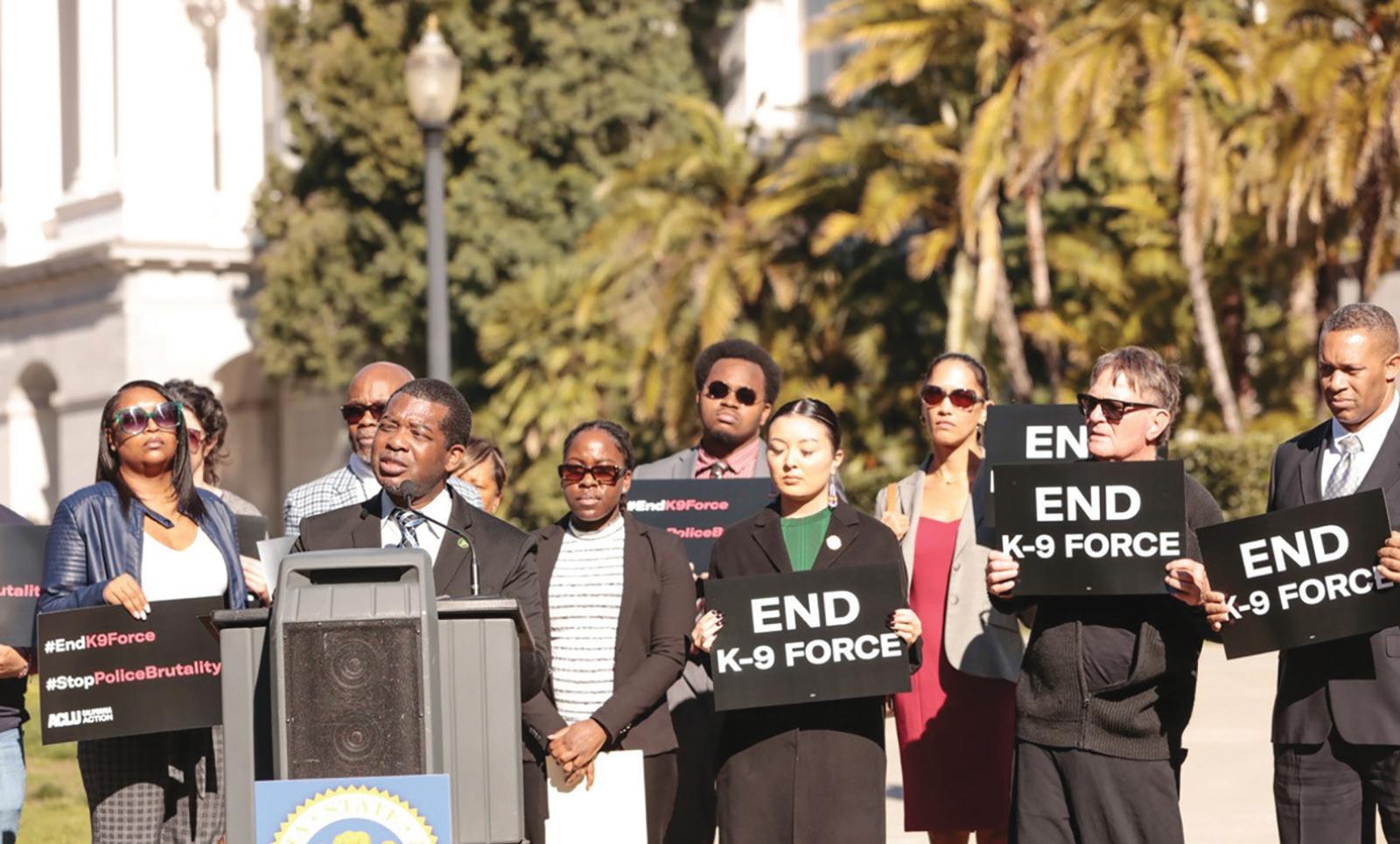
Ron Cloward, President for the Western States Police Canine Association and a veteran of the Modesto Police Department, said Jackson’s bill does not “make sense.” He argued that if AB 742 passes, it would take away one
Another bill in the package is AB 11. That bill would authorize the creation of a commission to identify sustainable solutions to reduce the cost of living in California. The commission would consist of 11 members, including nine members appointed by the Governor, the Speaker of the Assembly, and the President pro Tempore of the Senate. Also, one member each from the Assembly and the Senate would serve as ex officio non-voting members. The bill would require the commission to complete reports describing the commission’s findings and recommendations.
Planned Parenthood LA’s Black Health Initiative Expands Social Justice Services
LOS ANGELES – Planned Parenthood Los Angeles’s (PPLA) Black Health Initiative today announced its partnership with the Legal Aid Foundation of Los Angeles (LAFLA) and the UCLA Law Center on Reproductive Health, Law, and Policy (the Center) to provide free legal services to the Inglewood community.
“Planned Parenthood Los Angeles’ (PPLA) Black Health Initiative is proud to partner with the Legal Aid Foundation of Los Angeles (LAFLA) and the UCLA Law Center of Reproductive Health, Law, and Policy (the Center) by continuing to support better community health outcomes for underserved communities who are most impacted by historic and current racism and discrimination,” stated Celinda M. Vázquez, Chief External Affairs Officer for PPLA. “Through our partnership, we aim
to empower individuals to not only be better advocates for themselves and their families but also for their communities as a whole.”
The Planned Parenthood Inglewood Health Center is the flagship location of the Black Health Initiative, an agency-wide program designed to improve the overall wellbeing of African Americans by empowering communities to advocate for improved health outcomes. PPLA Inglewood, LAFLA, and the Center marked the launch of their partnership by hosting the first of 3 workshops on housing rights, followed in the coming weeks by government benefits, expungements, and family law.
LAFLA is a nonprofit law firm that seeks to achieve equal justice for people living in poverty across Greater Los Angeles through direct representation, systems change, and

community education. The partnership expands LAFLA’s unique combination of neighborhood offices, courthouse self-help centers, and domestic violence clinics at the forefront of change in diverse communities.
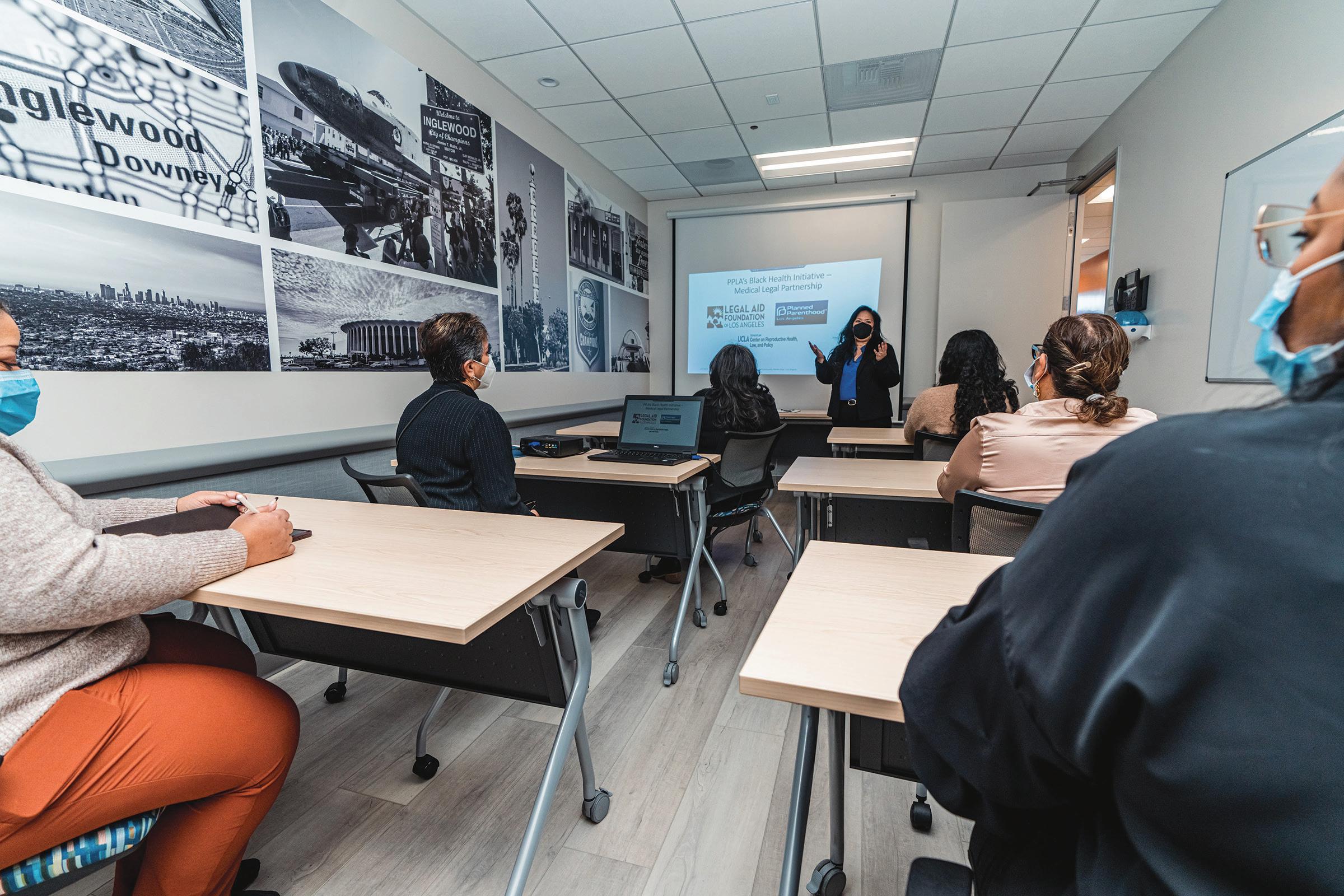
“The Legal Aid Foundation of Los Angeles’ partnership with Planned Parenthood’s Black Health Initiative is vital in ensuring that under-resourced communities have access to the legal and healthcare resources they need,” stated Silvia Argueta, executive director of LAFLA. “Together, we are working to break down barriers and empower individuals to advocate for their rights and well-being. This partnership is crucial in the fight for equity and justice.” Every year, LAFLA provides free, high-quality legal services to more than 100,000 residents with limited finances across Greater Los Angeles.
The Center is an interdisciplinary, national academic research center designed to train future reproductive law and policy leaders while empowering the advocates and scholars of today. Its partnership with PPLA allows UCLA Law students to better understand the challenges underresourced communities face due to legal issues.
“We are proud to partner with LAFLA and PPLA to advance reproductive justice for the Inglewood community,” said Grace Meng, Director of the Judge Rand Schrader Pro Bono Program at UCLA Law. “We are excited
to see the impact this project will have on the community’s reproductive health outcomes and for UCLA Law students to participate in a truly innovative project.”
The Inglewood Community Center and the Black Health Initiative reinforce PPLA’s commitment to providing Black and Brown communities with the resources needed to combat social and racial inequities by offering sexual and reproductive healthcare, prenatal care, behavioral health services, men’s and women’s health screenings, community education and now legal services from LAFLA in conjunction with the UCLA Law Center on Reproductive Health, Law, and Policy. For services not provided at the community center, community members will be referred to additional support that is accessible, culturally specific, and drives overall health, well-being, and racial justice.
Learn about LAFLA at https://lafla.org/ or call 800399-4529 and the Center at https://law.ucla.edu/academics/ centers/center-reproductive-health-law-and-policy.You can also log on to https://www.plannedparenthood.org/ for more information about the Black Health Initiative services offered through PPLA’s Inglewood Community Center or email info@pp-la.org.
2023 NBA All-Star Weekend Recap
By Jonathan McCoy Via Hoopsnrews.comAll-Star Weekend was a great experience. For one, it’s something that I’ve always watched on television and wanted to be associated with. Also, it’s like the NBA’s version of the Grammy’s. But without further ado, these are my top five takeaways from All-Star Weekend.
1- Giannis Antetokounmpo is the face of the NBA You couldn’t escape Giannis. He was everywhere and the camera embraced him. Even Friday night from the celebrity game he was everywhere. It was the first time where I felt like he could honestly be the face of the league one day. He was at every event all weekend and it seemed like he really appreciated being an All-Star and the responsibilities that came with it.
2- This All-Star Weekend Is a Made For TV Event When you are present, you get an understanding of how much of a production this weekend is when you go. It’s Taylor-Made for television. From the performances down to the actual events, it’s all made for TV viewing. Certain things look better on TV than even being there in person. Even the actual all-star game looked better rewatching it later on TV than it did watching it from in the arena.
3- Salt Lake City. Everything I’ve ever heard about Salt Lake City made it seem like a place that as a black man you never want to go. But at the same time, I’ve always been interested in the Pacific Northwest, because I think it’s beautiful scenery around, and it reminds me of the Midwest with mountains. I came to Salt Lake City with low expectations, and the city completely exceeded them in many ways.
Granted it was All-Star Weekend, so it may not have been the best representation of the city. All in all, it was a nice city. I was surprised at how courteous the people were. Everybody was extremely pleasant, I wasn’t expecting that; since all I’ve heard is hostile the crowd can be to players. I was expecting a different energy from the city. Kudos to Salt Lake City for being a great host.
4-Adam Silver Doesn’t Think What You Think Are Problems…Are Problems.
Load Management was one of the main topics addressed at Commissioner Adam Silver’s press conference Saturday night. He doesn’t think it’s the issue that the internet thinks it does. Although he did sympathize with fans that buy tickets to see players play, he also noted that the data even if a season was shortened doesn’t suggest that players would play more or less. League expansion seemed like more of a realistic thing to tackle for Silver than load management did. He mentioned that may be something the league might look into after the next collective bargaining agreement is in place.
5- The All-Star Game Itself

As Denver Nuggets Head Coach Mike Malone said, that was probably “one of the worst basketball games ever played.” I’ve seen games at LA Fitness be much more competitive than that. I think the game could stand some makeover, but there’s nothing the league can do. Guys have to take it upon themselves to come out and compete. There’s no reason the quarter-break dunk show should get more of a crowd reaction than anything that happened at the actual game. That’s not the game we grew up on, and I think I speak for many fans when we say we wish I could be better.
May-Treanor – Ribeiro Highlight Pala Casino 400
By Earl HeathContributing Sports Writer
Alfonso Ribeiro will serve as the honorary pace car driver for the Pala Casino 400, the final NASCAR Cup Series race on the famed 2-mile oval this Sunday. He will be joined by California native Misty May-Treanor who will be the honorary starter for the race. Ribeiro serves as host of ABC’s longest running show, “America’s Funniest Home Videos” and worked alongside Tyra Banks to co-host “Dancing with the Stars” for its 31st season.
“We’re ecstatic to have a performer of Alfonso’s caliber leading the field to green for the historic final race on our 2-mile oval,” said Auto Club Speedway President Dave Allen. “As a veteran in the television industry, Alfonso is all about entertaining and bringing joy to fans. He’ll find

himself right at home here at Auto Club Speedway, where fans are first.”
Ribeiro transitioned seamlessly from stage to TV, where his career found its home after landing a role on NBC’s “Silver Spoons.” Continuing his partnership with NBC, he spent six seasons establishing his iconic role as Carlton Banks on NBC’s smash-hit, “The Fresh Prince of Bel-Air.” Ribeiro soon stepped behind the camera to direct. Projects like “Meet the Browns,” “Are We There Yet?,” “One on One” and “Shake It Up” litter his expansive portfolio.
The beach volleyball champion will wave the green flag ahead of the highly-anticipated NASCAR Cup Series follow-up to the DAYTONA 500.
“We’re thrilled to have Misty as our honorary starter

at Auto Club,” said Dave Allen, President of Auto Club Speedway. “She’s an incredible athlete and a sporting legend of the highest degree – the perfect fit for this historic last race on the 2-mile oval.”
Throughout her career, May-Treanor amassed more than 100 championships and competed in four Olympic games, her first in Sydney in 2000; however, it wasn’t until the 2004 Athens games she won her first Olympic gold alongside teammate Kerri Walsh-Jennings. From there, the pair went on to win another gold medal in the 2008 games and again in 2012, becoming the most successful duo in the history of women’s beach volleyball with 112 consecutive wins – a record that still stands today.
In addition to being a decorated Olympian, May-
Treanor also holds the title of NASCAR Co-Grand Marshal. She, alongside other sporting legends gave the command before the inaugural Busch Light Clash at the Coliseum in 2022. Now, she’s back at another NASCAR event, adding a new accomplishment to her impressive resume – honorary starter for the Pala Casino 400.
“I’m honored to be part of the final race on Auto Club Speedway’s 2-mile oval,” said May-Treanor. “I can’t wait to feel the adrenaline in the air that always accompanies NASCAR racing.”
The Pala Casino 400 on Sunday will put an exclamation point on both an era in NASCAR history and a riveting double header race weekend. The NASCAR Xfinity Series’.
Stenhouse Jr Wins at Daytona
By Earl HeathContributing Sports Writer
It became a game of inches as Ricky Stenhouse Jr. edged out Joey Lagano to claim the 65th Daytona 500. In double overtime Stenhouse was ahead of Joey Logano at the moment of caution on the final lap to earn the biggest win of his NASCAR Cup Series career.

The 12-year NASCAR Veteran got his third win and first in 199 races.
Stenhouse battled back from a pit road speeding penalty, pushing Logano to the lead from the outside lane, making a daring move to the inside for the lead spot as contact between Austin Dillon and William Byron triggered a 13-car crash in Turn 3.
According to NASCAR rules who’s ever in the lead when the caution button is pushed is declared the winner.
“Its been really big for myself having not won since 2017and having struggles,” said Stenhouse. “Having someone like (crew chief) Mike Kelly is huge,” he added. “He I know you can still get this done, we’ve got to give you the right opportunities. We know if we give you cars that are capable of running up front you can do that we’ve proven that.”
Stenhouse was the only driver with out a team member.
There was a lot of strategy, a lot of switching and pushing. It was the longest Daytona 212 laps. There were 52 lead changes that involved 21 drivers. Brad Keselowski led the most laps with 42. Chris Buescher was second with 38. Logano was second was followed by Christopher Bell, Buescher and Alex Bowman rounded out the top five.
Kevin Harvick finished 12th in his last Daytona 500.
“Second is the worst man,” said Logano who won the race in 2015. “I was so close leading the white flag lap. You think you’re racing to the checkered flag and you put yourself in the best position to try to win at the start-finish line. There’s nothing like winning the Daytona 500 that’s why it stings so much finishing second.”

















